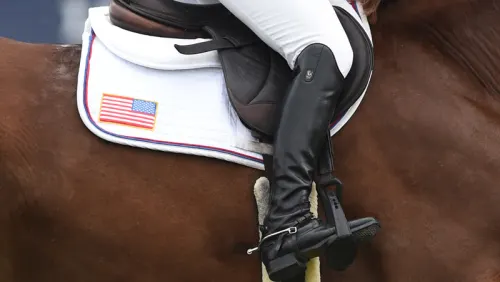When renowned French speedster Julien Epaillard is leading in a jump-off, most riders who come after him would know they’re riding for second. But Kent Farrington isn’t most riders.
Last to go in a 12-horse jump-off, Farrington took advantage of Gazelle’s foot speed to edge out Epaillard and win the $238,171 Hubside Jumping St. Tropez- Grimaud CSI5* in Grimaud, France, on June 20.
It’s the first win for Robin Parsky’s mare since she topped the $213,300 American Gold Cup Grand Prix CSI4* (Michigan) last September, but that’s by design. With the 15-year-old Belgian Warmblood (Kashmir Van Schuttershof—Diva ‘Ter Elsen’, Indoctro) aiming toward the Tokyo Olympic Games, Farrington has been planning her schedule carefully.
“My idea was to start the year very, very slow and know that in an older horse’s career, you probably only have one big run up for an event like that toward the end,” said the 40-year-old from Wellington, Florida. “You’re not going to be able to win all the grand prix [classes] in Florida and hold that kind of form for a year running. We started out very slow—I hadn’t done much after the Gold Cup last year. We’ve been building from there and trying to be in the best form as Tokyo approaches.”
How has your partnership developed with Gazelle?
Like any great combination in horse sport, it’s evolved over time. I’ve been riding the horse since she was 7, and she’s 15 now. I know the horse very well. I know her strengths and her weaknesses and also the evolution of a horse’s career as they age. Like any athlete, you start to rely more on experience and how well you know the horse, whereas when they’re younger you’re relying and leaning more into their athleticism and their youth. I think that’s one of the beauties of our sport, is it’s a constantly evolving process of working with an animal and both trying to be at your best.
Talk about how COVID-19 affected your planning and training and competition schedule in 2020.
ADVERTISEMENT
Everybody is doing the best that they can. I think we were lucky in America, where we were able to keep a lot of the industry going. There were a lot of events that were still able to run, which in other countries they weren’t as fortunate. So that helped.
Less travel for me meant more time with my young horses and more planning for the future. For the experienced horses, it was more about keeping them in enough work and picking some shows that they can do. Gazelle geared up for the Gold Cup, which was one of the bigger classes that we had in 2020. It was about keeping them in the game but at the same time letting them rest and saving their legs, so hopefully there’s more to do when the world started to come back to what we know as normal, and real competition picked up again.
What’s Gazelle’s routine when she’s not showing?
We try to treat her the best a horse can be treated.
She spends lots of time in a paddock, and she doesn’t spend too much time in the stall, so she’s constantly moving, going outside or being ridden. I work very little in the arena. I ride a lot on tracks or on trails to try keep the horses’ interest and keep their minds fresh for competition.
How do you mentally prepare for a big class?
I try to be as prepared as I can be, physically and mentally, so that it’s just another day at the office. If bigger-level competition or bigger-level pressure is a part of your normal routine, then it’s not really bigger-level pressure at a bigger-level competition; it’s just another competition. The more you can approach it that way,
the steadier and more consistent you can be in your approach.
ADVERTISEMENT
Speaking of being prepared physically, fitness is very important for you personally. How did that become such a major part of your routine?
I’ve always been that way. I’ve always been really into physical training from when I was a young kid. I used to work out in the morning before I would go to school when I was in grade school. I was always one of the smaller kids for sports, so I liked to be very strong—I wasn’t very big, but I was very strong for my size. I just always kept it up. It became something that gives me confidence. It helps me, knowing that I’m doing everything I can to be my best. I approach it from the aspect of, if we’re going to call ourselves athletes, then I’m going to be an athlete and live that life and approach it like I was a pro athlete.
Now I work out mainly on my own, but I’ve worked with many trainers over the years. After a certain amount of time I have a routine that works for me, and I run through that.
This article ran in The Chronicle of the Horse in our July 19 – August 2, 2021 issue.
Subscribers may choose online access to a digital version or a print subscription or both, and they will also receive our lifestyle publication, Untacked. Or you can purchase a single issue or subscribe on a mobile device through our app The Chronicle of the Horse LLC.
If you’re just following COTH online, you’re missing so much great unique content. Each print issue of the Chronicle is full of in-depth competition news, fascinating features, probing looks at issues within the sports of hunter/jumper, eventing and dressage, and stunning photography.















